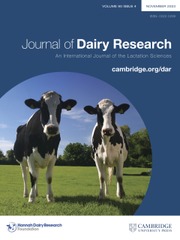No CrossRef data available.
Article contents
Nutritionally enriched whey-cereal-based fermented beverage with reduced faecal β-glucuronidase enzyme activity in a murine model
Published online by Cambridge University Press: 18 November 2025
Abstract
This research paper describes the effect of fermented substrates comprised of dairy by-products and underutilised cereals on murine faecal enzymes and faecal microbial profiles, and the development of the fermented substrate into a sour-spicy beverage for human consumption. A fermented substrate was made by using dairy by-products and underutilised cereals, whey and skim milk blend (60:40, v/v), germinated pearl millet flour and barley malt extract. The substrate was fermented with Lactobacillus acidophilus NCDC 13. The growth pattern of the organism in the composite substrate was satisfactorily described by a logistic-type equation. Faecal samples were obtained from 18 Swiss albino male mice that had been fed on either a control diet (n = 6), a diet based on an unfermented substrate, and a diet based on a fermented substrate (six in each group) and analysed. The fermented substrate caused a significant (P < 0.05) increment in faecal lactobacilli with a concomitant reduction in faecal coliform counts. Further, the fermented substrate caused a significant (P < 0.05) and sustainable decline in faecal enzyme β-glucuronidase activity in the mouse model, which is commonly considered a marker of colon cancer. The reductions in the numbers of coliform bacteria in faeces might explain the decline in faecal enzyme activity. Beta-glucuronidase is an enzyme produced by faecal bacteria that converts procarcinogens to potential carcinogens from available substrates. Bifidobacteria and lactobacilli generally have lower activities of these harmful enzymes, whereas β-glucuronidase is produced in high amounts by enterobacteria and clostridia spp. The fermented substrate was developed into a sour and spicy beverage for human consumption. The average TS, fat, protein, ash, starch and fibre contents of the beverage were 11%, 0.3%, 2%, 0.61%, 1% and 1.4%, respectively. The sensory score with an overall acceptability of 7.5, revealed that the product was sensory acceptable.
Information
- Type
- Research Article
- Information
- Copyright
- © The Author(s), 2025. Published by Cambridge University Press on behalf of Hannah Dairy Research Foundation.

